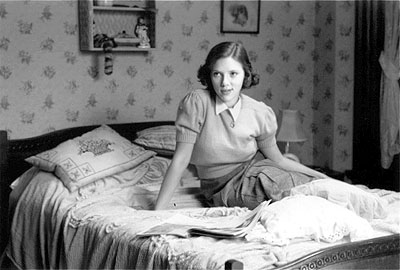
If Scarlett Johansson wants to go down on me in my car she’s more than welcome to!
Written By: Ethan & Joel Coen
Directed By: Ethan & Joel Coen
I recently directed the criticism towards the Coen Brothers The Hudsucker Proxy that their tribute to screwball comedy lacked any heart. The same criticism could be tossed onto The Man Who Wasn’t There, but that would be wrong. The Hudsucker Proxy tried to have heart, but it felt false. The Man Who Wasn’t There doesn’t try for heart because it isn’t a movie about heart, it’s a movie examining the life of a man and how he perceives things. It is slow, it is odd, it is a Coen Brothers movie. Most of all, it is a great film, a rarity in tone and style that sticks out like a sore thumb in the new millennium.
A major motion picture shot in black and white is an oddity nowadays, and by itself that adds an interesting aesthetic to The Man Who Wasn’t There. When you throw Roger Deakins into the mix as the cinematographer you end up with a treasure for the eyes. Throughout the film the visuals are beautiful, the movie uses shadow wonderfully and has a textured and layered look to it. The best looking scene in the film has to be when James Gandolfini pushes Billy Bob Thornton into the glass window and it cracks, slowly. From start to finish The Man Who Wasn’t There looks gorgeous, this is thee best looking Deakins film I have yet to see.
The music is also excellent in The Man Who Wasn’t There. It fluctuates from a more traditional movie score to actual traditional music effortlessly. I was most impressed with the music in the aforementioned Gandolfini/Thornton showdown at Nirdlinger’s. The music was heavy in that scene and combined with the performances and the visuals created such great tension.
There isn’t a lot of depth to the story or any of the characters in The Man Who Wasn’t There, but that is fine. That depth isn’t needed, because we are never supposed to get a full picture of anyone but Ed Crane. The film is seen through his eyes so what we see is all that he knows, what he narrates is all we are given on the characters. This creates a compelling noir, a tale that we become enveloped in because of one man.
Billy Bob Thornton was the perfect choice for Ed Crane. The rest of the cast is spot on as well, but Thornton perfectly embodies his character. He sounds and appears laconic, the movie is slow and moves at Thornton’s pace. He is subtle throughout, letting his character develop through minimal dialogue, facial ticks and cues. The Man Who Wasn’t There is the best I have ever seen from Billy Bob and I don’t know if it’s a role he can ever top.
Right off the bat the film is imbued with the Coen Brothers odd sense of humor and irony. This plays out through the rest of the movie, with tangents that may seem out of place but make perfect sense when viewed through that odd/ironic lens. The end of the movie is also perfectly in line with the tone of the film and the tact of the humor. It’s a cold ending, it takes a while to develop, but the journey has been a cold one and one that has taken its time to get from point A to point Z.
While I do find the Coen Brothers to be remarkable filmmakers, The Man Who Wasn’t There was a surprise to me. I thought it might be good, but I didn’t know it would end up great. It’s no Fargo, but it’s in that echelon and a welcome addition to my experiences with the Coen Brothers. But, Billy Bob, what are you thinking? You never pass up road head, especially when it looks like that!
Rating:
****
Cheers,
Bill

Pingback: Postulating & Pontificating: Directing Props, Pt. 2! | Bill's Movie Emporium
Pingback: Awesome outstanding superduper movies you may have missed « Frothy Ruminations